by Lodi Vet | Sep 18, 2018 | Educational Materials, Equine
Making the decision to euthanize an equine companion is never easy. Even if the time may be right for our horse, it may not feel like the right time for us to be saying goodbye to our friend. The end of a beloved horse’s life can be a very difficult time. Not only are we faced with the loss of a companion, but decisions must be made regarding care of the body.
Beginning in late spring of 2018, most livestock removal and rendering services in our area began no longer accepting horses euthanized with the drug that had previously been used. The reason for this is to increase the safety of animal feed products, but as a result our livestock removal options have changed and may continue to do so as new regulations evolve. Please check with our office about current changes if you have any questions or concerns.
Some disposal options currently available include:
Burial: If you own land, you may want to have your horse buried on your property. To do so, you should research the laws for your location. Some counties prohibit burial, or if they allow it, there may be specifications about the depth and size of the hole, its location in relation to water sources, and how the body should be handled. Please look up local ordinances prior to burial.
Landfill: Horses may be taken to a local landfill (certain landfills only). This requires a special trailer and winching system for loading and unloading the body. Each landfill has its own regulations and limits on size and number of horse(s), and drop off times and days. Please call ahead.
Cremation: You can arrange to have your horse cremated with or without the cremains returned to you. There are two companies that service our area: Midwest Cremation Service and Brier Hill Livestock Removal. Both companies provide a pick-up service that will take your horse’s body directly to the crematorium.
Brier Hill Livestock Removal
847-652-4839
brierhilllivestock@gmail.com
Midwest Cremation Service:
608-635-7270
www.mcsofwi.com
Livestock Removal: This used to be the most utilized option until laws about chemical euthanasia changed in May 2018. At the present time these services will only pick up if your horse is euthanized by gunshot or captive bolt or died of natural causes. Gunshot and captive bolt euthanasias are approved by the American Veterinary Medical Association as an acceptable route of euthanasia. These services do occasionally offer Saturday pickup.
Marshall Stock Removal
608-655-3439
Granite Stock Removal
920-566-2563
The doctors and staff at Lodi Veterinary Care understand how difficult the loss of an equine companion can be. We are available to discuss any questions, emotions, or concerns that you may have so please feel free to contact us. Here you will find a wealth of support and a group of concerned, loving individuals who understand the depth of the human-animal bond.
by Lodi Vet | Sep 7, 2018 | Educational Materials, Equine, Uncategorized
Hay is a crucial part of an equine diet in the Midwest, and its nutrition content can play a big role in what grain and supplements your horse may or may not need. When creating a nutrition plan for your horse(s), we recommend a hay analysis. A hay analysis is easy to obtain and can tell you a lot about the forage your horses are eating.
What information can a hay analysis provide?
Sugar content
- The sugar content is key for horses with metabolic conditions such as Pituitary Pars Intermedia Dysfunction (PPID, or “Cushings”) as these horses should ideally be limited to hay which is less than 10% NSC, the non-structural carbohydrates.
- When limited hay is not an option, we often recommend soaking hay in cold water, which can decrease the NSC level by approximately 30%
Digestibility and consumability
- Are your horses wasting a large amount of the hay you provide? The consumability may be low if so.
- Poor digestibility can lead to “hay belly” appearance.
Calcium content
- Calcium can indicate the amount of alfalfa in the hay (more calcium = more alfalfa)
Mineral content
Digestible energy
- How much energy can be extracted from the hay
The Relative Feed Value (RFV)
- RFV is the overall quality of the hay, graded out of 200
- An average hay is typically between 95-115.
- Keep in mind that not every horse (in fact many horses!) don’t need the highest quality hay!
Moisture content
- High moisture can lead to spoilage more easily
Crude protein
- Especially important for horses with impaired kidney function, as they can’t balance their protein as effectively
Another key reason to have your hay analyzed is to better determine how much grain (if any) is needed based on the horses’ demands and requirements. In other words, a hay analysis is crucial to properly balance a ration.
Testing the Hay
It’s ideal if we can sample a random assortment of 8-10 bales to get an idea of the overall quality of the hay. From each of those bales we obtain a cross-sectional “core” sample across a large area of the bale.
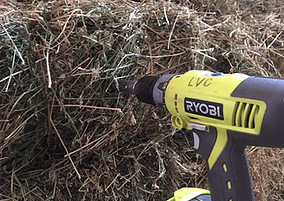
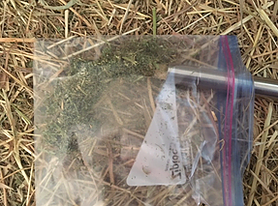
Lodi Veterinary Care provides hay sampling services as well as diet/nutrition analysis recommendations. If you’d like to schedule a time for us to pick up a sample or if you have any other questions, please give us a call at (608) 592-7755.
by Lodi Vet | Sep 5, 2018 | Cats, Dogs, Educational Materials, How To
- Take a new syringe from the package (syringes are single use only, call or visit us to get refills on syringes when needed)
- Draw up 0.25ml of the red Vitamin B12 solution (measure from the top of the black plunger).
- Pull up the skin between the shoulder blades to create a skin “tent”
- Insert the whole needle into the skin (pointing downward towards the body), make sure the needle has not exited the skin on the other size of the skin “tent”.
- Inject the total volume of Vitamin B12 under the skin.
- Discard the used needle into a Sharps container, syringes are single use only. When Sharps container is full, it can be returned to Lodi Veterinary Care for proper disposal.
by Lodi Vet | Sep 3, 2018 | Cats, Educational Materials, How To
One thing to keep in mind is that cats will do their best to make pilling difficult. Cats are not too fond of having their mouths pried open, let alone allowing you to insert a pill in their mouth. Some cats will salivate excessively, so it is very important that you learn how to pill a cat quickly and efficiently.
STEP 1: Restraint
There are three ways to restrain a cat:
- Restraint 1: Kneel on ground. Place the cat between your legs with its face near your knees. Squeeze slightly with your legs just enough so the cat won’t escape.
- Restraint 2: Use a towel to restrain if the cat is too wiggly. Wrap the cat up like you would if you were wrapping a burrito/taco. Be careful not to wrap too tight. If needed, this can go with step 1.
- Restraint 3: If you have someone available to help, have them hold the cat on a table cradled next to their body. Have the person hold the front legs and chest tight so the cat can’t get away. You can then concentrate on giving the pill, not chasing the cat.
STEP 2: The actual pilling
- Put your “off-hand” on top of cat’s head. Place thumb and forefinger on the side ridges of face, just behind jaw. Gently raise the head until it points to the ceiling in an upward position.
- As the mouth opens, use your other hand to hold the pill and press down on lower jaw, dropping or pushing the pill as far back on the tongue as possible. If this is not easy to do, you may use a piller, which is a device designed to make pilling easier to do.
STEP 3: Making sure the pill has been swallowed.
- Once the pill is placed in the mouth, close the mouth making sure you or your partner still have a firm hold on the cat. Rub the throat and nose, or blow into the cat’s face softly to get the cat to swallow the pill. The desired result is to get the cat to lick its nose, which forces the swallowing action. When the cat has swallowed the pill, you may offer a small amount of water to wash the pill down.
- When finished give lots of praise to your cat. If these techniques do not work, please call Lodi Veterinary Care and we can assist you with any problems.
Alternatives/Suggestions:
- It is not ideal to crush the medication and mix with food. Most often your cat will detect the medication and refuse to eat it. You will also not know if the entire dose of medication was ingested.
- Coat the pill with butter. This will allow the medication to slide down easier.
- Greenies Pill Pockets for Cats are available at Lodi Veterinary Care. These meaty pockets provide you with a means to hide the medication in a tasty treat most cats will like.
- If you do not like the idea of putting your fingers inside your cat’s mouth, there are cat pillers available at Lodi Veterinary Care. These pillers allow you to safely bring the medication to the back of your cat’s mouth for ease of administration.
- If your cat has been prescribed antibiotics and you are having difficulty giving the medication, you might be in luck. In most cases there is an injectable antibiotic available. This injectable will give 10-14 days of antibiotic coverage without the hassle.
by Lodi Vet | Aug 31, 2018 | Educational Materials, Equine
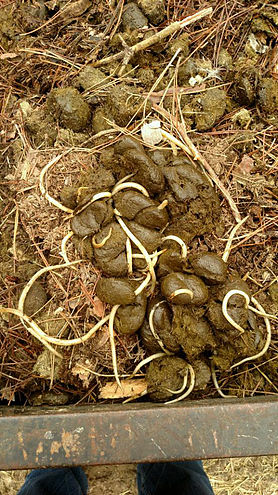 The way it used to be:
The way it used to be:
What is Strategic Deworming?
Strategic Deworming involves determining a Fecal Egg Count (FEC) by counting the number of parasite eggs, and using that number, along with the specific identification of which types of parasites are present, to better select a dewormer. Only about 20% of horses harbor about 80% of parasites, so the same deworming program shouldn’t be used for all horses.
Goals of Strategic Deworming:
-
Tailor deworming to the individual horse, time of year, geographic location, and exposure level. This means using the right dewormer, at an effective dose, at the best times.
-
Limit overuse of dewormers to prevent resistance. Resistance can be present regionally or more locally on specific farms.
-
Evaluate a dewormer’s effectiveness on a certain farm by checking a fecal before and after deworming.
-
The goal is NOT to eradicate all the parasites or to make every horse into a “low shedder”.
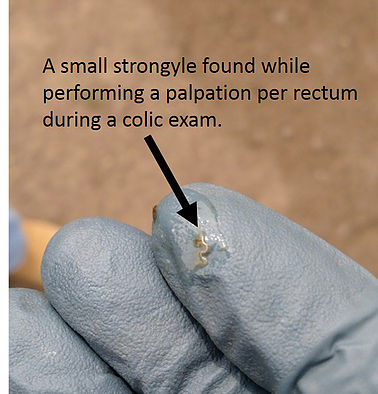
Manure management:
Parasites are part of the normal intestinal fauna of grazing animals: horses and parasites evolved together. Actively managing horses (fences etc) causes an imbalance to this relationship.
-
By far the best parasite management practice is to remove manure frequently from pastures and pens
-
Deworm new horses prior to introduction, and keep visitors separated.
-
Mowing and harrowing pastures: this exposes eggs and larvae to the killing effects of air and sunlight. Works best when temperatures are at least 85°F.
-
Rotational grazing: allows larval stages to die before horses are exposed. Ideally combine rotational grazing with mowing/harrowing.
General recommendations for adult horses:
Discuss with your veterinarian if the below protocol is a good fit for your horses. Many factors influence a deworming program including manure management, animal density, and general health of the horses. Please wait at least 4 weeks after most recent deworming to submit a sample for a fecal egg count.
SPRING: Check a fecal egg count
-
Low shedder (<200 epg): deworm with ivermectin
-
Moderate shedder (200-500 epg): deworm with ivermectin and recheck fecal in 4 weeks
-
High shedder (>500 epg): deworm with ivermectin now and repeat in 4 weeks, then recheck fecal 4 weeks after second deworming.
FALL: Check a fecal egg count
-
Low shedder (<200 epg): deworm with ivermectin and praziquantel combination
-
Moderate shedder (200-500): deworm with ivermectin and praziquantel combination and recheck fecal in 4 weeks
-
High shedder (>500 epg): deworm with ivermectin and praziquantel combination then deworm with ivermectin (no praziquantel). Recheck fecal in 4 weeks. If continues to be high, deworm with moxidectin.
-
If a horse is showing overt symptoms of intestinal parasitic disease, perform a fecal egg count and discuss a deworming protocol with your veterinarian. Moxidectin may be recommended to kill encysted larvae in these horses.
Tapeworms:
Praziquantel is used to treat for tapeworms. Tapeworms do not show well on a standard fecal; however, in this area deworming with praziquantel once yearly is typically adequate. Praziquantel is included with ivermectin in EquiMax (recommended) and Zimectrin Gold. Praziquantel is included with moxidectin in QuestPlus.
For horses less than three years old:
-
If you acquired a horse less than 3 years old and it has no deworming history, please consult a veterinarian prior to deworming them for the first time. These horses should have an individualized plan for deworming. If a young horse contains a large number of parasites, they may be at risk for a severe impaction colic caused by die-off of ascarid parasites. This could require surgery and can even cause death.
-
Foals should receive at least 4 deworming treatments within their first year of life.
-
@ 2-3 months old, deworm with oxibendazole
-
@ 4-6 months old, deworm with oxibendazole
-
@ 9 months, deworm with an ivermectin and praziquantel combination
-
@ 12 months, check a fecal and deworm with either ivermectin or oxibendazole depending on the predominant parasite type seen.
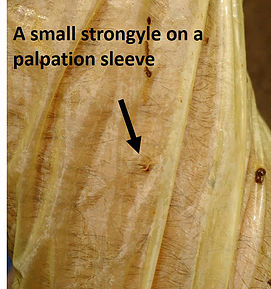 How do I submit a manure sample for a fecal egg count?
How do I submit a manure sample for a fecal egg count?
It’s easy! All we need is 1-2 fresh fecal balls per horse. If possible, try to collect from the center of a manure pile so they are not dried out or covered in bedding, sand, or dirt. Place into a clean zip-lock bag and label with your first and last name, horse’s name, and date of collection. If you have a rough idea of when the horse was last dewormed and what product was used, that is helpful information for formulating a deworming program best suited to your horse. Keep the sample in the fridge or in a cooler with ice packs until it gets to us. You can drop off samples at any of our three locations (Lodi, DeForest, or Portage); give it to us at your next appointment; or call to arrange pick-up.
Please don’t hesitate to call with any questions or to discuss a deworming protocol specific to your horse!
by Lodi Vet | Aug 17, 2018 | Educational Materials, Equine, Uncategorized, Wellness
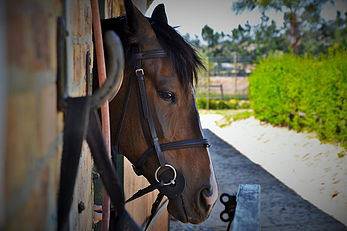 What is a Coggins Test?
What is a Coggins Test?
A coggins is a test for equine infectious anemia (EIA) which is a viral disease.
Facts about EIA
EIA is spread by blood-feeding insects such as horseflies, stable flies , and deer flies. It can also be transferred in utero, or via equipment or blood products (ex. blood transfusion).
Once infected, horses may show fever, swelling of lower legs, weakness, or petecchia (small bruises on gums). Horses that survive this phase usually become carriers and can spread the disease without even showing any signs.
There is no treatment for this disease; positive horses can be quarantined for the rest of their lives but are typically euthanized. In just one week, 3 horses in Georgia were confirmed positive for Equine Infectious Anemia and were euthanized.
Preventative measures focus on eliminating vectors, such as: using insect repellents, reducing standing water, managing manure waste, and cleaning pastures.
When is a Coggins Test Needed?
-
Most equine events/shows require a negative coggins test performed within the past twelve months
-
Out-of-state health certificate
-
Sales
-
Some boarding facilities require a negative coggins test



 The way it used to be:
The way it used to be:
 How do I submit a manure sample for a fecal egg count?
How do I submit a manure sample for a fecal egg count? What is a Coggins Test?
What is a Coggins Test?